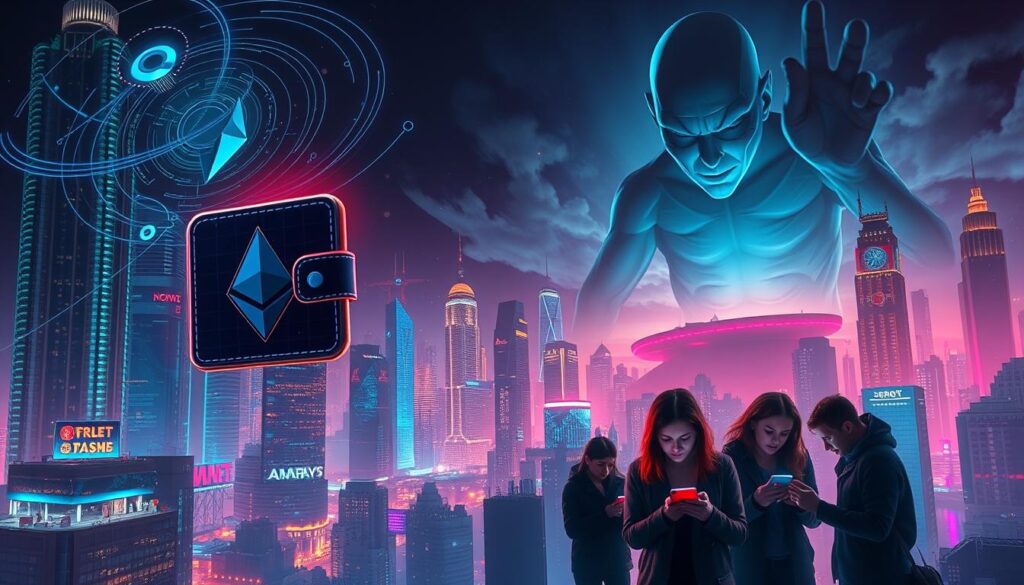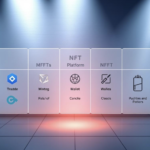Now Reading: Cheapest Way to Buy NFTs Without Gas Fees Guide
- 01
Cheapest Way to Buy NFTs Without Gas Fees Guide
Cheapest Way to Buy NFTs Without Gas Fees Guide

Navigating the world of NFTs often comes with hidden costs, from fluctuating marketplace fees to unpredictable gas charges. For creators and collectors, these expenses can quickly eat into profits or inflate purchase prices. Understanding how to minimize transaction costs is key to maximizing value in this fast-paced market.
Popular platforms like OpenSea and Magic Eden have gained traction partly due to their competitive fee structures. Meanwhile, emerging solutions like Immutable X leverage Layer-2 blockchain technology to slash transaction costs by up to 90%. Community-driven alternatives such as Rarible also provide creative models for cost-efficient trading.
This guide breaks down practical strategies for accessing digital collectibles while keeping expenses low. Whether you’re new to NFT marketplaces or a seasoned trader, you’ll discover how blockchain innovations and platform-specific features create opportunities for smarter transactions. We’ll explore how timing, network selection, and marketplace comparisons impact your bottom line.
Key Takeaways
- Gas fees on Ethereum can exceed $150 during network congestion
- Layer-2 solutions like Immutable X dramatically reduce transaction costs
- Marketplace fee structures vary widely between platforms
- Alternative blockchains often have lower base transaction fees
- Timing transactions during off-peak hours can yield savings
- Some platforms absorb gas fees to attract users
Introduction to Gas-Free NFT Buying
Digital collectible enthusiasts face a hidden hurdle: transaction costs that can spiral unexpectedly. On Ethereum, these fees—called gas fees—reward validators for processing smart contracts. During peak times, gas fees multiply, turning simple NFT trades into costly endeavors.

Other blockchains use different models. Solana and Polygon charge minimal transaction fees instead, often under $0.01 per trade. This shift enables more accessible NFT trading without the financial strain of Ethereum’s network congestion. Platforms like Immutable X bypass gas fees entirely using Layer-2 technology, creating smoother experiences for users.
| Blockchain | Average Cost | Transaction Speed |
|---|---|---|
| Ethereum | $15–$150+ | 3–5 minutes |
| Solana | $0.00025 | <1 second |
| Immutable X | $0 gas fees | Instant |
These alternatives reduce costs by up to 99% compared to traditional Ethereum-based platforms. For artists and collectors, this means broader access to NFTs without sacrificing security or functionality. The evolution of fee structures reshapes how communities engage with digital assets, prioritizing inclusivity over exclusivity.
Understanding Gas Fees and Their Impact on NFT Trading
Blockchain transactions come with a price tag that often catches users off guard. Gas fees act as fuel for processing actions like minting or transferring digital assets. These costs rise and fall based on network activity, creating financial hurdles for casual traders and seasoned professionals alike.

Breakdown of Gas Fees in NFT Transactions
Every NFT transaction involves multiple cost layers. On Ethereum, gas fees cover computational work for smart contracts. During peak hours, these fees can spike to $150 per action. Additional expenses include:
- Marketplace commissions (2–5% per sale)
- Listing fees for auctions
- Crypto conversion charges
| Action | Average Gas Fee | Network Impact |
|---|---|---|
| Minting | $40–$150 | High congestion |
| Bidding | $15–$50 | Moderate traffic |
| Transferring | $10–$30 | Low activity |
How Gas Fees Affect Creators and Collectors
Artists face recurring gas costs when minting collections. Many resort to bulk creation to spread fees across multiple pieces. For example, minting 100 NFTs at once reduces per-item costs by 60–80%.
Collectors encounter fees during purchases and wallet transfers. These charges often surpass the value of affordable digital art, pushing buyers toward platforms with fixed-rate transaction fees. The unpredictability forces both parties to strategize timing and platform selection carefully.
Exploring Gas-Free Marketplaces and Layer-2 Solutions
The next evolution in digital collectibles arrives through gas-free platforms that redefine accessibility. These NFT marketplaces eliminate financial friction using advanced blockchain scaling methods. By shifting transaction processing off the main network, they maintain security while slashing costs.

Benefits of Gas-Free Minting Options
Creators gain unprecedented flexibility with platforms that charge fees only upon successful sales. This model removes upfront costs for artists testing new concepts. Immutable X demonstrates this approach, allowing creators to list 10,000 NFTs without initial gas expenditures.
Three key advantages emerge:
- Reduced financial risk for experimental projects
- Automatic cost distribution across sold items
- Increased creative freedom through scalable production
Layer-2 Technologies in NFT Trading
These solutions process thousands of transactions per second through secondary networks. Final settlements occur periodically on the main blockchain, maintaining decentralization. The result? Instant trades with fees under $0.01 become standard.
| Platform | Technology | Average Fee |
|---|---|---|
| Immutable X | StarkEx L2 | $0 gas |
| Element | zkRollups | $0.003 |
| OpenSea (Polygon) | Sidechain | $0.05 |
This technical leap empowers both established artists and newcomers. Collectors benefit from faster confirmations and predictable costs, transforming how NFT marketplaces operate. The shift toward Layer-2 infrastructure marks a pivotal moment for sustainable digital asset trading.
Product Roundup: Cheapest Way to Buy NFTs Without Gas Fees
Choosing the right platform significantly impacts NFT acquisition costs. Modern marketplaces now compete through innovative fee models and blockchain integrations. This shift empowers users to access digital assets while minimizing overhead.

Top Platforms for Gas-Free NFT Transactions
Leading NFT marketplaces balance affordability with diverse collections. OpenSea dominates with 80 million assets but charges 2.5% per sale. Alternatives like Magic Eden leverage Solana’s $0.00025 transactions, while Binance NFT uses its native blockchain for sub-$0.01 trades.
Four platforms redefine cost efficiency:
- X2Y2: 0.5% fees with optional royalty payments
- LooksRare: 2% charges plus token rewards
- Magic Eden: Solana-based instant settlements
- Binance NFT: BSC integration for cross-chain flexibility
| Platform | Blockchain | Fees |
|---|---|---|
| OpenSea | Ethereum/Polygon | 2.5% |
| X2Y2 | Ethereum | 0.5–2% |
| Magic Eden | Solana | Free gas |
Decentralized options provide user-controlled wallets but require technical familiarity. Centralized platforms simplify onboarding through custodial accounts. Both models now offer NFTs without paying Ethereum’s volatile gas prices, creating accessible entry points for new collectors.
Deep Dive into Leading NFT Marketplaces
The competitive landscape of NFT platforms reveals distinct strategies for attracting creators and collectors. OpenSea, Magic Eden, and Binance NFT each employ unique approaches to transaction fees, blockchain integration, and specialized tools. Their differences highlight how marketplace design shapes user experiences and costs.
Comparative Analysis of Platform Ecosystems
OpenSea dominates with multi-chain flexibility, supporting Ethereum and Polygon networks. Its 2.5% fee applies to sales, while creators enjoy free minting capabilities. The platform’s 80-million-asset catalog appeals to diverse collectors, from digital art enthusiasts to cryptocurrency investors.
Magic Eden leverages Solana’s speed for gaming-focused collections. A 2% transaction charge funds its launchpad services and custom creator tools. This specialization makes it the go-to platform for play-to-earn projects and metaverse assets.
Binance NFT stands out with 1% fees and direct access to 120 million exchange users. Its BSC integration enables cross-chain trades while maintaining institutional-grade security protocols.
| Feature | OpenSea | Magic Eden | Binance NFT |
|---|---|---|---|
| Base Fee | 2.5% | 2% | 1% |
| Blockchain | Multi-chain | Solana | BSC |
| Specialization | General collectibles | Gaming NFTs | Premium categories |
Strategic Advantages for Different Users
Artists favor OpenSea’s no-cost minting for experimental drops. Game developers cluster on Magic Eden for its tailored launch support. Traders prioritizing low transaction fees often choose Binance NFT’s streamlined ecosystem.
These platforms demonstrate how fee structures influence market positioning. While OpenSea offers breadth, Magic Eden delivers niche expertise, and Binance NFT provides cost efficiency. Each approach reshapes how communities interact with digital assets.
Leveraging Binance Smart Chain for Cost-Effective NFT Trading
Traders seeking affordable digital asset exchanges increasingly turn to streamlined ecosystems. The Binance Smart Chain stands out with its low-cost infrastructure, designed to support high-volume NFT trading without Ethereum’s price volatility. Its integration with the broader Binance ecosystem creates a unified experience for crypto enthusiasts.
Why Binance NFT Appeals to Modern Collectors
This platform simplifies onboarding by connecting directly to users’ exchange accounts. No separate wallet setups or complex transfers are needed. The 1% transaction fee structure remains among the most competitive in the industry.
Key benefits include:
- BNB gas fees averaging $0.10 per transaction
- Access to 120 million potential buyers through Binance’s network
- Multi-category collections spanning sports, gaming, and digital art
| Feature | Binance Smart Chain | Ethereum |
|---|---|---|
| Average Fee | $0.10 | $15–$150+ |
| Transaction Speed | 3 seconds | 5 minutes |
| Platform Fee | 1% | 2.5%+ |
Staking BNB tokens unlocks additional fee discounts, enhancing cost efficiency. Artists benefit from instant settlement and exposure to Binance’s global user base. This combination makes the smart chain ideal for frequent traders and first-time buyers alike.
Community-Driven Marketplaces and Fair Fee Models
A new wave of NFT platforms puts power back in users’ hands through democratic governance. These marketplaces like Rarible and LooksRare enable collective decision-making about fee structures and platform updates. Unlike traditional models, every participant helps shape the ecosystem’s future.
How Rarible Rewards Active Participation
Rarible operates as a decentralized autonomous organization (DAO) powered by its RARI token. Holders vote on critical updates like royalty splits and fee adjustments. The platform charges 2.5% per transaction while letting creators earn up to 50% on secondary sales.
LooksRare’s Trading Incentives Explained
This marketplace stands out with its LOOKS token rewards system. Users earn tokens for listing, buying, and selling NFTs – creating built-in loyalty perks. The model keeps collectors engaged even during slow market periods.
| Feature | Rarible | LooksRare |
|---|---|---|
| Base Fee | 2.5% | 2% |
| Governance Token | RARI | LOOKS |
| Royalty Range | Up to 50% | Flexible |
Both platforms demonstrate how community-driven models create fairer ecosystems. Users benefit from transparent policies and direct influence over platform evolution. This approach reshapes expectations for NFT marketplaces across the industry.
Alternatives to Ethereum-Based NFT Platforms
The blockchain ecosystem offers diverse paths for collectors prioritizing speed and affordability. While Ethereum remains dominant, networks like Polygon and Solana provide compelling technical advantages. These alternatives address critical pain points through optimized architectures.
Blockchain Innovations Reshaping Digital Collectibles
Polygon’s Ethereum-compatible framework supports instant trades at 1/100th of mainnet costs. Its multi-chain ecosystem attracts projects needing scalable solutions without sacrificing interoperability. Artists benefit from near-instant finality and predictable pricing.
Solana’s architecture achieves 65,000 transactions per second, making it ideal for high-volume markets. Platforms like Magic Eden leverage this speed for gaming assets and dynamic collections. With average fees below $0.01, creators can experiment freely while maintaining profitability.
Emerging chains like Flow and Avalanche further diversify options. Flow’s user-friendly design powers NBA Top Shot, while Avalanche combines Ethereum compatibility with sub-second confirmations. Each network caters to specific use cases, from sports memorabilia to Solana-based platforms hosting generative art projects.
These ecosystems prove that innovation extends beyond transaction costs. Enhanced scalability, specialized tooling, and community-focused features collectively redefine what digital ownership means. As networks evolve, collectors gain unprecedented flexibility in curating their portfolios.











